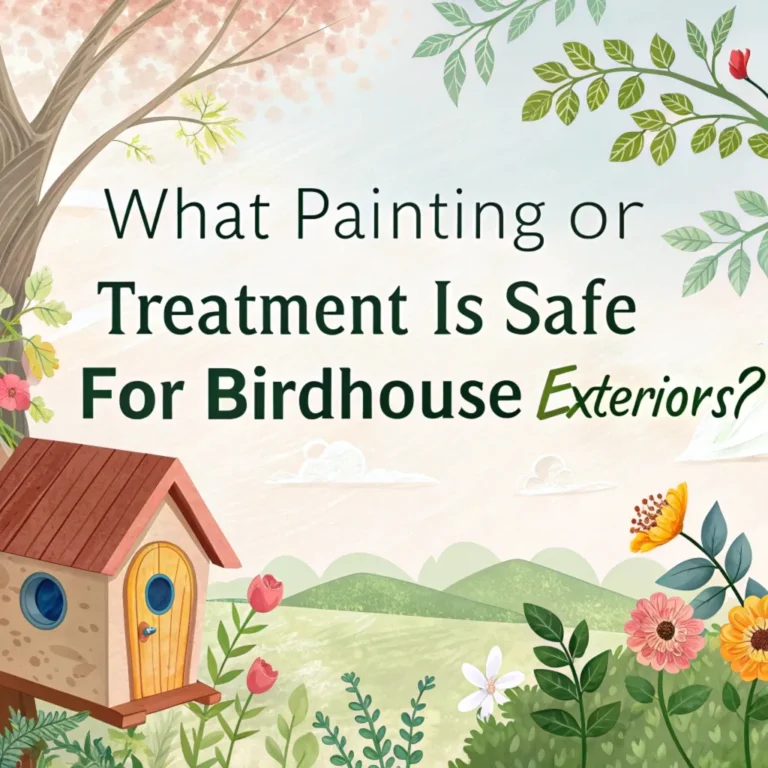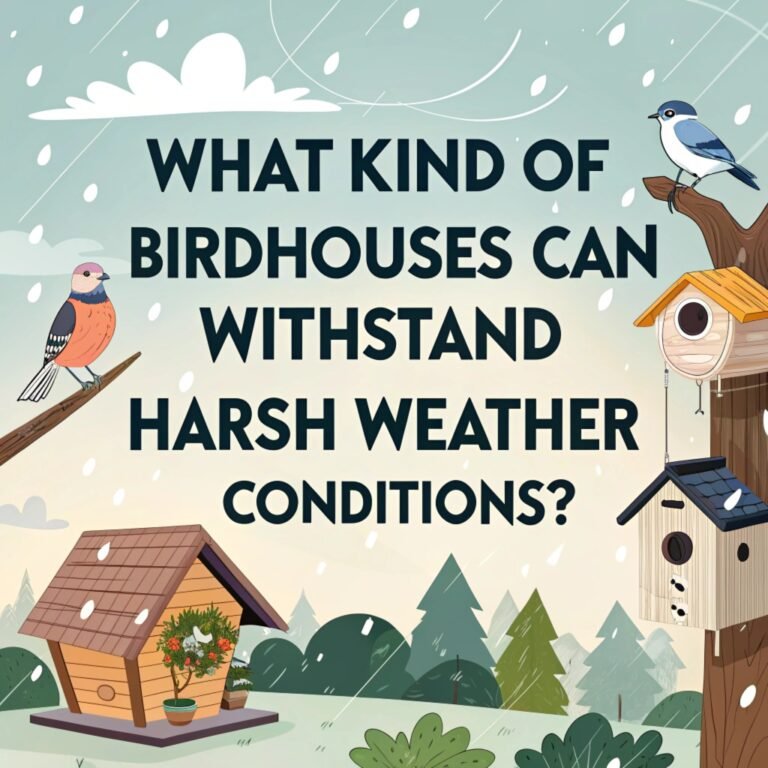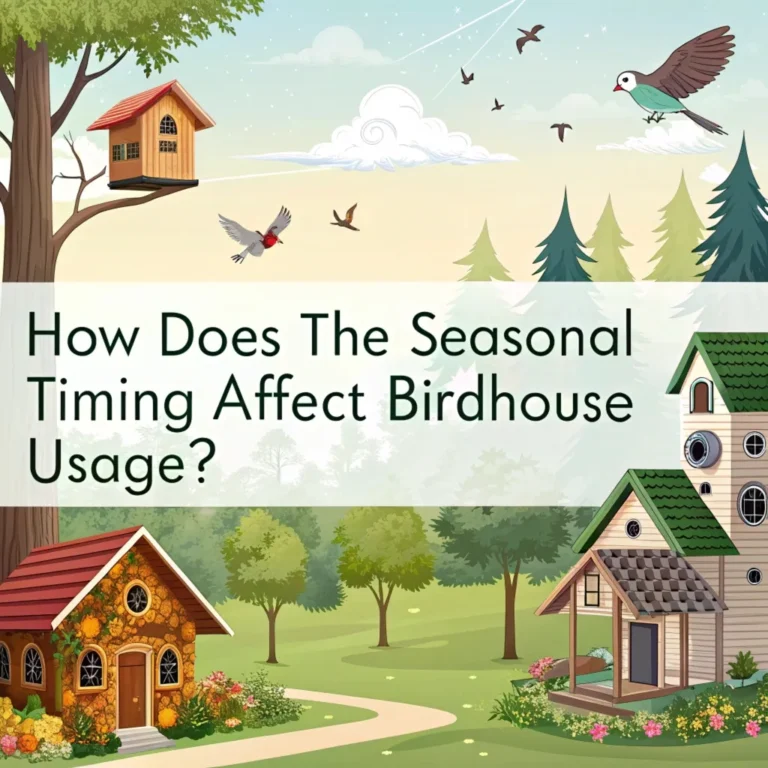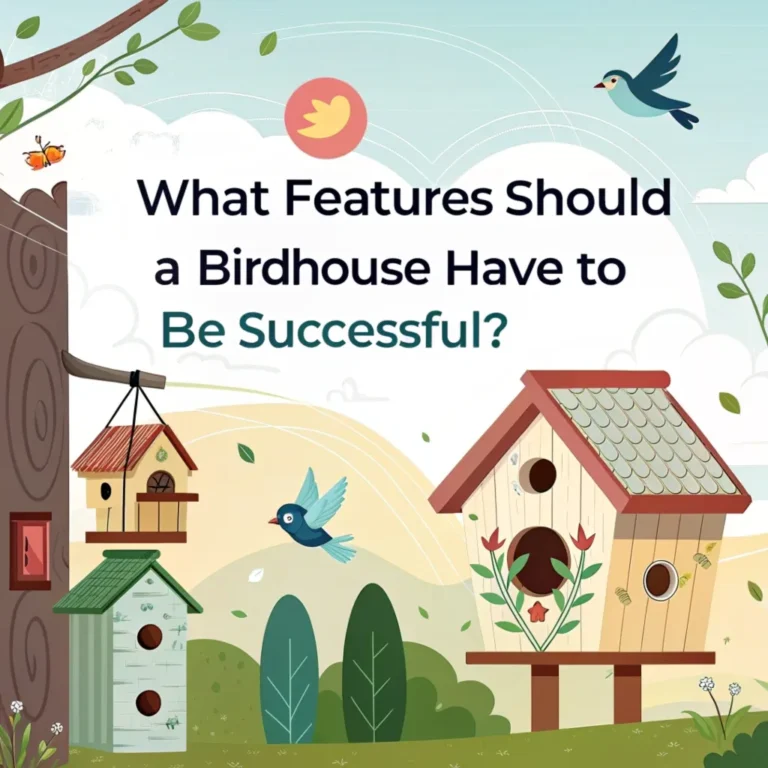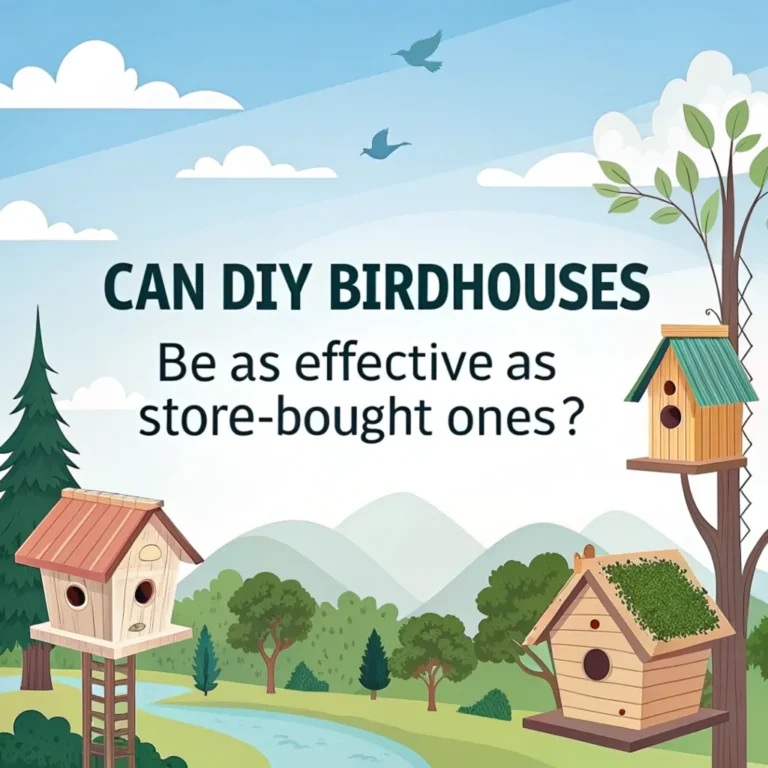How do you Attract Nesting Birds to Your Birdhouse? Tips for a Successful Birdhouse
Creating a welcoming environment for nesting birds in your backyard can be a rewarding experience.
By providing the right birdhouse and following specific strategies, you can attract a variety of feathered friends to make their homes in your outdoor space.
This guide will explore effective methods to encourage birds to nest in your birdhouse, from selecting the right design to creating an inviting habitat.

Key Takeaways
- Choose the right birdhouse: Select a birdhouse with appropriate dimensions and materials for your target species.
- Proper placement: Position birdhouses in suitable locations, considering factors like height, direction, and surrounding environment.
- Provide essential resources: Offer food, water, and nesting materials to attract birds.
- Maintain a safe environment: Implement measures to protect birds from predators and harsh weather conditions.
- Regular maintenance: Clean and maintain birdhouses to ensure they remain attractive to nesting birds.
- Diverse housing options: Offer multiple birdhouses to accommodate different species and reduce competition.
- Natural surroundings: Create a bird-friendly landscape with native plants and natural features.
- Timing is crucial: Install birdhouses before the breeding season begins.
- Avoid harmful practices: Refrain from using pesticides and keep cats indoors to protect birds.
- Patience and observation: Monitor birdhouses regularly and be patient as birds discover and choose their nesting sites.
Attracting nesting birds to your birdhouse is a fascinating endeavor that requires careful planning and attention to detail.
By creating an inviting environment, you can provide a safe haven for various bird species to raise their young.
This process not only enhances the biodiversity of your garden but also offers a unique opportunity to observe the intricate behaviors of nesting birds up close.
As you embark on this bird-friendly journey, it’s important to remember that success may not be immediate. Birds are naturally cautious creatures and may take time to discover and trust new nesting sites.
However, with persistence and proper care, you can create a thriving bird community in your backyard, contributing to local conservation efforts and enjoying the vibrant presence of these feathered visitors throughout the year.
Select the Right Birdhouse
Choosing an appropriate birdhouse is crucial for attracting nesting birds. Consider these factors:
- Size: Different bird species require specific dimensions. For example, bluebirds need a house that’s 5.5 by 5.5 inches and 10 inches tall, while wrens prefer smaller houses.
- Entrance hole size: The diameter of the entrance hole is critical. Bluebirds need a 1.5-inch hole, while wrens require a 1.125-inch opening.
- Materials: Use untreated wood and galvanized screws for construction. Avoid bright colors and opt for natural tones.
- Ventilation and drainage: Ensure the birdhouse has proper ventilation holes and a sloped roof with an overhang to keep the nest dry.
- Access for cleaning: Choose a design that allows easy access for regular cleaning and monitoring.
The selection of a birdhouse is a critical step in attracting nesting birds to your garden. Each species has unique preferences for their nesting sites, and by catering to these specific needs, you can significantly increase the likelihood of birds choosing your birdhouse.
Consider researching the common bird species in your area to understand their particular requirements and tailor your birdhouse selection accordingly.
When constructing or purchasing a birdhouse, pay attention to the quality of materials and craftsmanship. A well-built birdhouse not only provides better protection for nesting birds but also lasts longer, requiring less frequent replacement.
Additionally, consider incorporating features like removable roofs or side panels to facilitate easy cleaning and monitoring without disturbing the nest during the breeding season.
Optimal Placement

The location of your birdhouse plays a significant role in attracting nesting birds:
- height: Install birdhouses at the appropriate height for your target species. Most songbirds prefer houses 5 to 10 feet above the ground.
- Direction: Face the entrance hole away from prevailing winds, typically towards the east or southeast.
- Clear flight path: Ensure there’s an unobstructed path to the entrance hole for easy access.
- Habitat considerations: Place birdhouses in locations that match the preferred habitats of your target species.
The strategic placement of your birdhouse can make a significant difference in its attractiveness to nesting birds. Consider the natural habitat preferences of the bird species you’re targeting and try to mimic these conditions in your yard.
For example, bluebirds prefer open areas with scattered trees, while chickadees may be drawn to more wooded settings.
When positioning your birdhouse, also take into account the surrounding landscape and potential hazards. Avoid placing birdhouses near areas with high human traffic or where predators might easily access them.
Additionally, consider the proximity to food and water sources, as birds are more likely to choose nesting sites that offer easy access to these essential resources.
Provide Essential Resources
Offering necessary resources will make your birdhouse more attractive:
- Food sources: Install bird feeders near the birdhouse, but not too close to avoid attracting predators.
- Water: Place a bird bath or shallow water source within sight of the birdhouse.
- Nesting materials: Provide natural fibers, such as twigs, grass, and leaves, for birds to use in nest construction.
Creating a comprehensive ecosystem for birds involves more than just providing a nesting site. By offering a variety of resources, you can create an irresistible environment that encourages birds to not only nest but also thrive in your backyard.
Consider planting native berry-producing shrubs or maintaining a small area of your lawn for seed-producing wildflowers to provide natural food sources.
In addition to food and water, offering nesting materials can be a significant draw for birds. You can create nesting material stations by filling suet cages or mesh bags with items like pet fur, small twigs, or cotton fibers.
Place these stations near your birdhouses to make it convenient for birds to gather materials for their nests. Remember to avoid using dryer lint or synthetic fibers, as these can be harmful to birds.
Ensure a Safe Environment

Creating a safe nesting area is essential:
- Predator guards: Install baffles or predator guards to protect the birdhouse from cats, squirrels, and other threats.
- Proper mounting: Securely attach the birdhouse to a pole, tree, or building to prevent it from falling.
- Weather protection: Ensure the birdhouse offers adequate shelter from rain, wind, and direct sunlight.
Safety is paramount when it comes to attracting and protecting nesting birds. Predators can pose a significant threat to both adult birds and their offspring, so taking measures to deter potential threats is crucial.
Consider using metal poles instead of wooden ones for mounting birdhouses, as they are more difficult for predators to climb. Additionally, installing motion-activated sprinklers or lights near your birdhouses can help deter nocturnal predators.
Another aspect of ensuring a safe environment is protecting birds from human interference. Educate family members and visitors about the importance of minimizing disturbances around nesting sites.
Consider creating designated observation areas at a safe distance from the birdhouses, allowing people to enjoy watching the birds without causing stress or disruption to their nesting activities.
Regular Maintenance
Maintaining your birdhouse will keep it attractive to birds:
- Annual cleaning: Remove old nesting material and clean the interior with a mild bleach solution before each breeding season.
- Repairs: Check for and fix any damage to the birdhouse, such as loose screws or cracks.
- Painting: For painted birdhouses, reapply a coat every few years to maintain their appearance and protection.
Proper maintenance of your birdhouses is crucial for ensuring their long-term effectiveness in attracting nesting birds. Regular upkeep not only prolongs the life of the birdhouse but also creates a healthier environment for its inhabitants.
When cleaning, be sure to wear gloves and a mask to protect yourself from any potential parasites or diseases that may be present in old nesting materials.
In addition to cleaning and repairs, consider monitoring the birdhouses throughout the nesting season. Keep a log of activity, noting which species are using the houses and any issues that arise.
This information can help you make informed decisions about future birdhouse placement and design improvements. Remember to conduct these checks discreetly to avoid disturbing nesting birds.
Offer Multiple Housing Options
Providing various birdhouse types can attract different species:
- Different sizes: Install birdhouses with varying dimensions to accommodate different bird species.
- Multiple locations: Place birdhouses in different areas of your yard to reduce competition and offer choices.
- Specialized houses: Consider adding specific designs for certain species, such as purple martin houses or owl boxes.
Diversity in housing options can significantly increase the variety of bird species that nest in your yard. By offering a range of birdhouse styles and sizes, you create opportunities for different birds to find their ideal nesting sites.
This approach not only enhances biodiversity but also reduces competition among bird species for limited nesting spaces.
When planning your birdhouse arrangement, consider creating small colonies for species that prefer communal nesting, such as purple martins. For solitary nesters, ensure adequate spacing between houses to prevent territorial conflicts.
Additionally, experiment with different mounting heights and locations to cater to the preferences of various bird species, from ground-nesting birds to those that prefer higher elevations.
Create a Bird-Friendly Landscape
Developing a natural habitat will encourage birds to nest:
- Native plants: Incorporate native trees, shrubs, and flowers that provide food and shelter for birds.
- Diverse vegetation: Offer a mix of plant types and heights to create various nesting options.
- Natural features: Include rock piles, brush piles, and dead trees to provide additional nesting sites and food sources.
Creating a bird-friendly landscape goes beyond simply installing birdhouses. By designing your garden with birds in mind, you can create a holistic ecosystem that supports various aspects of bird life.
Consider incorporating layered vegetation, from ground cover to tall trees, to provide diverse habitats for different bird species. This approach not only attracts more birds but also enhances the overall ecological value of your property.
When selecting plants for your bird-friendly landscape, prioritize native species that are well-adapted to your local climate and provide natural food sources for birds. Include a mix of evergreen and deciduous plants to offer year-round shelter and food.
Additionally, consider leaving some areas of your yard less manicured, allowing for natural leaf litter and fallen branches that can provide foraging opportunities and nesting materials for ground-feeding birds.
Timing is Key
Installing birdhouses at the right time is crucial:
- Early placement: Set up birdhouses before the breeding season begins, typically by late winter or early spring.
- Year-round availability: Keep birdhouses up throughout the year to provide shelter for non-migratory birds during winter.
The timing of birdhouse installation can significantly impact its success in attracting nesting birds. Different bird species have varying breeding schedules, so it’s important to research the nesting habits of your target species.
For many North American birds, the breeding season begins in early spring, but some may start looking for nesting sites as early as late winter.
While it’s ideal to have birdhouses in place before the breeding season, don’t be discouraged if you’re starting late. Some bird species have multiple broods throughout the spring and summer, providing opportunities for late-season nesting.
Additionally, maintaining birdhouses year-round can offer valuable shelter for birds during harsh weather conditions, potentially increasing the likelihood of them choosing your birdhouse for nesting in the following season.
Avoid Harmful Practices
Certain practices can deter nesting birds:
- Pesticide use: Avoid using chemical pesticides that can harm birds and reduce their food sources.
- Outdoor cats: Keep cats indoors or supervised to prevent them from preying on nesting birds.
- Disturbances: Minimize human activity near birdhouses during the nesting season.
Creating a safe environment for nesting birds involves more than just providing suitable housing; it also requires eliminating potential threats.
The use of pesticides can have devastating effects on bird populations, not only through direct poisoning but also by reducing their insect food sources.
Consider adopting organic gardening practices and natural pest control methods to maintain a healthy ecosystem for birds and other wildlife.
Managing pet interactions with wildlife is another crucial aspect of bird conservation. While it may be challenging for cat owners, keeping felines indoors or in enclosed outdoor spaces can significantly reduce bird mortality.
If outdoor time is necessary, consider using cat bibs or bells on collars to alert birds of the cat’s presence. Additionally, educate neighbors about the impact of free-roaming cats on bird populations to promote community-wide conservation efforts.
Monitor and Be Patient
Attracting nesting birds requires patience and observation:
- Regular checks: Monitor birdhouses periodically to ensure they remain in good condition and are being used.
- Record keeping: Keep a log of bird activity to track which species are using your birdhouses.
- Adjustments: Be prepared to make changes to your setup based on observed bird preferences and behaviors.
Monitoring your birdhouses is not only crucial for maintenance but also provides valuable insights into the success of your efforts. Develop a consistent monitoring schedule, checking birdhouses at regular intervals throughout the nesting season.
Use this time to observe from a distance, noting any bird activity around the houses without causing disturbance.
Keeping detailed records of your observations can be both rewarding and informative. Note the species using each birdhouse, the dates of occupancy, and any notable behaviors or events.
This information can help you refine your approach over time, making informed decisions about birdhouse placement, design, and surrounding habitat.
Remember that attracting nesting birds is an ongoing process, and each season brings new opportunities to learn and improve your bird-friendly environment.
FAQs
How long does it take for birds to start using a new birdhouse?
It can take several weeks to months for birds to discover and start using a new birdhouse. Patience is key, as birds need time to find and assess potential nesting sites.
Can I use a birdhouse with a perch?
It’s best to avoid birdhouses with perches. Natural cavity-nesting birds don’t need them, and perches can make it easier for predators to access the nest.
How often should I clean my birdhouse?
Clean your birdhouse once a year, preferably in late fall or early winter after the breeding season has ended. This ensures a clean, safe environment for the next nesting season.
What if unwanted species use my birdhouse?
If invasive species like House Sparrows use your birdhouse, you may need to adjust the entrance hole size or relocate the house to discourage them and attract your target species.
Can I watch the birds inside the birdhouse?
While it’s tempting to observe nesting birds closely, it’s best to minimize disturbances. If you want to monitor activity, consider using a birdhouse camera that allows remote viewing without disturbing the birds.
By following these guidelines and creating a welcoming environment, you can significantly increase the chances of attracting nesting birds to your birdhouse. Remember that each bird species has unique preferences, so be prepared to adapt your approach based on the birds in your area. With patience and care, you’ll soon enjoy the rewarding experience of hosting nesting birds in your backyard.

Luna is the passionate founder and author of Birds and You, a website dedicated to sharing her love for birds with fellow enthusiasts. Through her engaging articles and guides, she aims to educate and inspire others to explore the fascinating world of birds. When she’s not writing, you can find Luna observing birds in their natural habitats or sharing beautiful bird photography on Pinterest. Join her on this journey to celebrate and protect our feathered friends!


